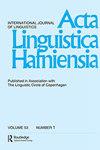当代法罗语中的have/be交替
Q2 Arts and Humanities
引用次数: 4
摘要
摘要本文研究了法罗语中have (hava)和be (vera)作为助动词与过去分词/supine结合的情况。我们提出了两项在线问卷研究的结果,并认为数据表明,在法罗语中,have/be交替是完成助动词的交替,就像丹麦语一样,但与其他斯堪的纳维亚语言不同,在这些语言中,be只能用来表达结果状态。本文章由计算机程序翻译,如有差异,请以英文原文为准。
The have/be alternation in contemporary Faroese
Abstract This paper investigates the status of the alternation in Faroese between have (hava) and be (vera) as auxiliaries combining with the past participle/supine. We present the results of two online questionnaire studies and argue that the data indicate that in Faroese the have/be alternation is an alternation of perfect auxiliaries, like in Danish but unlike the other Scandinavian languages, where be can only be used to convey resultant state.
求助全文
通过发布文献求助,成功后即可免费获取论文全文。
去求助
来源期刊

Acta Linguistica Hafniensia
Arts and Humanities-Language and Linguistics
CiteScore
0.90
自引率
0.00%
发文量
5
 求助内容:
求助内容: 应助结果提醒方式:
应助结果提醒方式:


